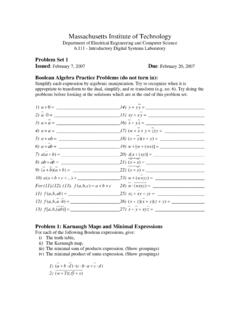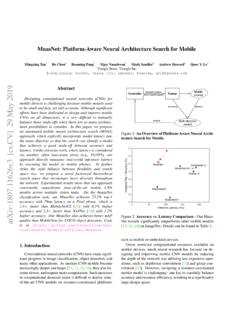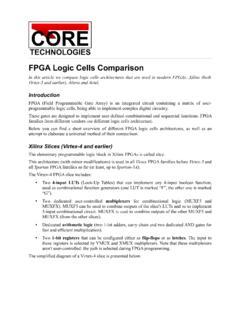Transcription of Synchronization in Digital Logic Circuits
1 Synchronization in Digital Logic Circuits Ryan Donohue Synchronization : Why care? Digital Abstraction depends on all signals in a system having a valid Logic state Therefore, Digital Abstraction depends on reliable Synchronization of external events 1. The Real World Real World does not respect the Digital Abstraction! n Inputs from the Real World are usually asynchronous to your system clock n Inputs that come from other synchronous systems are based 8 PORT. on a different system clock, which Gigabit is typically asynchronous to your Ethernet Switch system clock Metastability When asynchronous events enter your synchronous system, they can cause bistables to go into metastable states Every real life bistable (such as a D-latch) has a metastable state Vout CLK VTC of '1' state series inverters D Q.
2 Vin Vout VTC of metastable feedback state 0. D Vin Q. 1 Vout CLK. '0' state Vin 2. Quick Metastability Review '0' state '1' state '0' state '1' state FF in 'normal' states FF in metastable state Once a FF goes metastable (due to a setup time violation, say) we can't say when it will assume a valid Logic level or what level it might eventually assume The only thing we know is that the probability of a FF coming out of a metastable state increases exponentially with time Mean Time Between Failures For a FF we can compute its MTBF, which is a figure of merit related to metastability.
3 Tr resolution time (time since clock edge). (tr/ ) f sampling clock frequency MTBF(t r) = e a asynchronous event frequency Tofa and To FF parameters For a typical .25um ASIC library FF. For f = 100 MHz, MTBF = days tr = a = 1 MHz = To = 3. Synchronizer Requirements Synchronizers must be designed to reduce the chances system failure due to metastability Synchronizer requirements n Reliable [high MTBF]. n Low latency [works as quickly as possible]. n Low power/area impact Single signal Synchronizer Traditional synchronizer n SIG is asynchronous, and META might go metastable from time to time n However, as long as META resolves before the next clock period SIG1 should have valid Logic levels n Place FFs close together to allow maximum time for META to reslove CLK.
4 SIG META SIG1. D Q D Q SIG. META. CLK SIG1. 4. Single Synchronizer analysis MTBF of this system is roughly: (tr / ) (t / ) For a typical .25um MTBF(tr ) = e x e r Tofa Tof ASIC library FF. tr = For f = 100 MHz, MTBF = 10 years = Age of Earth = 5x10 9 years a = 1 MHz To = Can increase MTBF by adding more series stages SIG META SIG1 SIG2. D Q D Q D Q. CLK. Flip Flop design is important? Dynamic FFs not suitable for synchronizers since they have no regeneration CLK CLK . D Q.. D Q . CMOS Dynamic FF TSFF (Svenson). Special SYNC' FFs should be used for the primary synchronizer if available 5.
5 SYNC Flip Flop SYNC Flip flops are available in some ASIC. libraries n Better MTBF characteristics due to high gain in the feedback path n Very large (5x regular FF) and very high power Vout VTC of '1' state SYNC FF. series inverters SIG META SIG1 VTC of D Q D Q regular FF. SYNC series inverters CLK. '0' state Vin Synchronization Pitfall Never synchronize the same signal in multiple places! Inconsistency will result! SIG1. D Q D Q. SYNC. CLK. SIG. SIG2. D Q D Q. SYNC. CLK. 6. Bus Synchronization Obvious approach is to use single signal synchronizers on each bit WRONG! SIG[0] SIG1[0].
6 D Q D Q. SYNC. CLK. CLK. SIG[0]. SIG[1]. SIG[1] SIG1[1]. D Q D Q SIG1[0]. SYNC. SIG1[1]. CLK. Handshaking is the Answer Need a single point of Synchronization for the entire bus CLK. SIG[1:0]. REQ. ACK. SIG 2. REQ. D Q DQ. Hand CLK2 Hand shaking shaking FSM FSM. ACK. Q D Q D. CLK1. CLK1 CLK2. 7. Handshaking Rules Sender outputs data and THEN asserts REQ. Receiver latches data and THEN asserts ACK. Sender deasserts REQ, will not reassert it until ACK deasserts Receiver sees REQ deasserted, deasserts ACK. when ready to continue CLK. SIG[1:0]. REQ. ACK. Alternate Handshaking Scheme Previous example is known as 4-phase handshaking 2-phase (or edge based) handshaking is also suitable n Sender outputs data and THEN changes state of REQ, will not change state of REQ again until after ACK changes state.
7 N Receiver latches data. Once receiver is ready for more it changes state of ACK. 2-phase requires one bit of state be kept on each side of transaction. Used when FFs are inexpensive and reliable reset is available. 8. High Bandwidth solutions Handshaking works great, but reduces bandwidth at the clock crossing interface because each piece of data has many cycles of series handshaking. Correctly designed FIFOs can increase bandwidth across the interface and still maintain reliable communication Abstract FIFO design Ideal dual port FIFO writes with one clock, reads with another FIFO storage provides buffering to help rate match load/unload frequency Flow control needed in case FIFO gets totally full or totally empty DATA_IN DATA_OUT.
8 EMPTY. FULL. CLK1 CLK2. 9. FIFO in detail FIFO of any significant size is implemented using Dual Port SRAM. an on-chip SRAM PORT 1 PORT 2. SRAM must be dual- FULL WR_PTR RD_PTR EMPTY. ported for our design DATA_IN FIFO WR_DATA RD_DATA FIFO DATA_OUT. WRITE READ. [have two independent Logic Logic . ports] CLK1 CLK2. We will use a write pointer to determine the write address, and a read pointer to determine the read address FIFO pointer control FIFO is managed as a FFh circular buffer using FEh pointers. First write will occur at WRITE. address 00h. Next write PNTR. n bits of data n bits of data will occur at 01h.
9 N bits of data n bits of data After writing at FFh, next READ. n bits of data n bits of data write will wrap to 00h. PNTR. 01h 00h Reads work the same way. First read will occur at address 00h. 10. FIFO pointers and flow control Generation of FULL and EMPTY signals. n FIFO is FULL when write pointer catches read pointer always @(posedge clk1). FULL <= (WR_PNTR == RD_PNTR) && ((OLD_WR_PNTR + 1 == RD_PNTR) || FULL). n FIFO is empty when read pointer catches write pointer always @(posedge clk2). EMPTY <= (WR_PNTR == RD_PNTR) && ((OLD_RD_PNTR + 1 == WR_PNTR) || EMPTY). Write pointer and read pointer must never pass each other.
10 N Write passing read overwrites unread data n Read passing write re-reads invalid data FIFO in detail We have a problem! Dual Port SRAM. PORT1 PORT 2. FULL WR_PTR RD_PTR EMPTY. DATA_IN FIFO WR_DATA RD_DATA FIFO DATA_OUT. WRITE READ. Logic Logic . CLK1 CLK2. To generate FULL/EMPTY conditions the write Logic needs to see the read pointer and the read Logic needs to see the write pointer! 11. Pointer Synchronization Our pointers change in a very specific way (when they change, they increment by 1). n Applying a traditional two stage FF synchronizer on each bit of a binary pointer could cause a wildly invalid pointer value to be produced n Gray coding the pointer value means at most one bit will change per cycle we can only be off by one'.














![Abstract arXiv:1611.05431v2 [cs.CV] 11 Apr 2017](/cache/preview/b/8/4/6/e/f/c/6/thumb-b846efc624a92f9b5a173084e67ead39.jpg)



